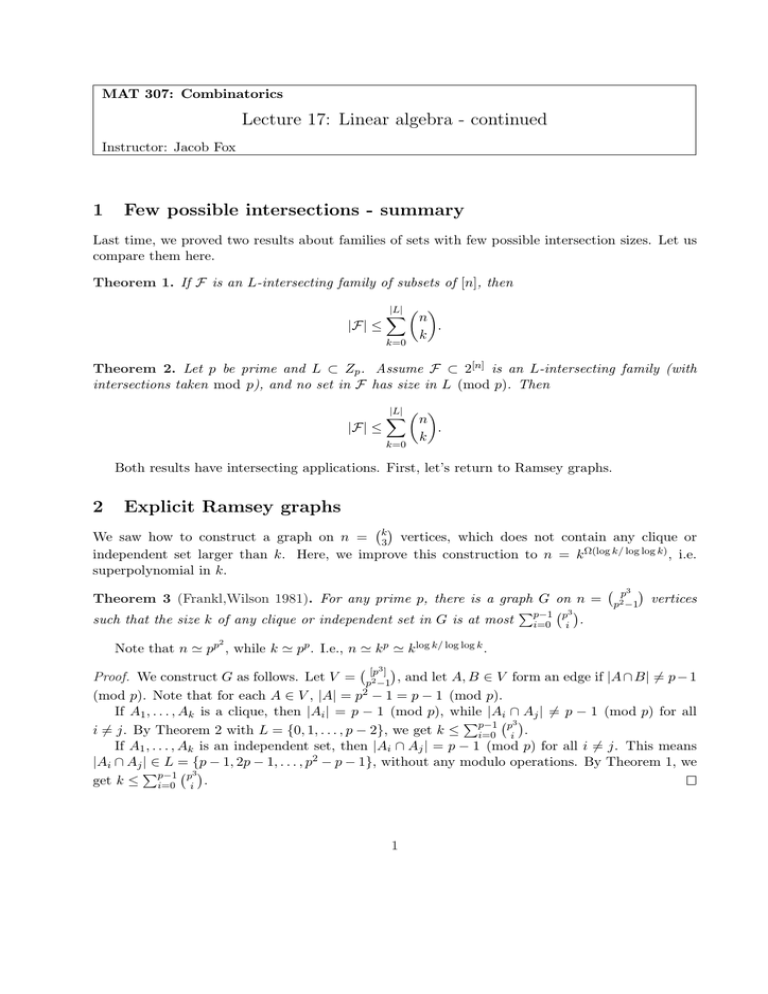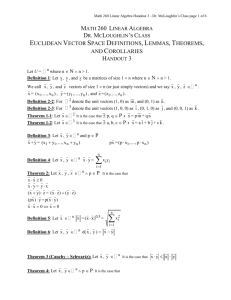Lecture 17: Linear algebra - continued 1 Few possible intersections - summary
advertisement

MAT 307: Combinatorics
Lecture 17: Linear algebra - continued
Instructor: Jacob Fox
1
Few possible intersections - summary
Last time, we proved two results about families of sets with few possible intersection sizes. Let us
compare them here.
Theorem 1. If F is an L-intersecting family of subsets of [n], then
|F| ≤
|L| µ ¶
X
n
.
k
k=0
Theorem 2. Let p be prime and L ⊂ Zp . Assume F ⊂ 2[n] is an L-intersecting family (with
intersections taken mod p), and no set in F has size in L (mod p). Then
|L| µ ¶
X
n
|F| ≤
.
k
k=0
Both results have intersecting applications. First, let’s return to Ramsey graphs.
2
Explicit Ramsey graphs
¡ ¢
We saw how to construct a graph on n = k3 vertices, which does not contain any clique or
independent set larger than k. Here, we improve this construction to n = k Ω(log k/ log log k) , i.e.
superpolynomial in k.
¡ 3 ¢
Theorem 3 (Frankl,Wilson 1981). For any prime p, there is a graph G on n = p2p−1 vertices
¡p3 ¢
P
such that the size k of any clique or independent set in G is at most p−1
i=0 i .
2
Note that n ' pp , while k ' pp . I.e., n ' k p ' k log k/ log log k .
¡ 3 ¢
Proof. We construct G as follows. Let V = p[p2 −1] , and let A, B ∈ V form an edge if |A ∩ B| =
6 p−1
2
(mod p). Note that for each A ∈ V , |A| = p − 1 = p − 1 (mod p).
If A1 , . . . , Ak is a clique, then |Ai | = p − 1 (mod p), while |Ai ∩ Aj | 6= p − 1 (mod p) for all
¡p3 ¢
P
i 6= j. By Theorem 2 with L = {0, 1, . . . , p − 2}, we get k ≤ p−1
i=0 i .
If A1 , . . . , Ak is an independent set, then |Ai ∩ Aj | = p − 1 (mod p) for all i 6= j. This means
|Ai ∩ Aj | ∈ L = {p − 1, 2p − 1, . . . , p2 − p − 1}, without any modulo operations. By Theorem 1, we
¡p3 ¢
P
get k ≤ p−1
i=0 i .
1
3
Borsuk’s conjecture
Can every bounded set S ⊂ Rd be partitioned into d + 1 sets of strictly smaller diameter?
This conjecture was a long-standing open problem, solved in the special cases of a sphere S
(by Borsuk himself), S being a smooth convex body (using the Borsuk-Ulam theorem) and low
dimension d ≤ 3. It can be seen that a simplex requires d + 1 sets, otherwise we have 2 vertices in
the same part and hence the diameter does not decrease.
The conjecture was disproved dramatically in 1993, when Kahn and Kalai showed that significantly more than d + 1 parts are required.
Theorem 4. For any d sufficiently large, there√exists a bounded set S ⊂ Rd (in fact a finite set)
such that any partition of S into fewer than 1.2 d parts contains a part of the same diameter.
The proof uses an algebraic construction, relying on the following lemma.
¡ ¢
4p such that every
Lemma 1. For any prime p, there exists a set of 12 4p
2p vectors F ⊆ {−1, +1}
¡ 4p ¢
subset of 2 p−1 vectors contains an orthogonal pair of vectors.
Proof. Consider 4p elements and all subsets of size 2p, containing a fixed element 1:
F = {I : I ⊆ [4p], |I| = 2p, 1 ∈ I}.
For each set I, we define a vector viI = +1 if i ∈ I and viI = −1 if i ∈
/ I. We set F = {v I : I ∈ F}.
The only way that a pair of such vectors v I , v J can be orthogonal is that |I∆J| = 2p and then
|I ∩ J| = p. Note that |I ∩ J| is always between 1 and 2p − 1 (I, J are different and they share at
least 1 element). Hence v I · v J = 0 iff |I ∩ J| = 0 (mod p).
We claim that this is the desired collection of vectors. For a subset G ⊂ F without any
orthogonal pair, we would have a family of sets G ⊂ F such that
• ∀I ∈ G; |I| = 0 (mod p).
• ∀ distinct I, J ∈ G; |I ∩ J| ∈ {1, 2, . . . , p − 1} (mod p).
By Theorem 2,
|G| ≤
p−1 µ ¶
X
4p
k=0
k
µ
<2
¶
4p
.
p−1
Now we are ready to prove the theorem.
Proof. Given a set of vectors F ⊆ Rn = R4p provided by the lemma above, we define a set of
vectors
2
X = {v ⊗ v : v ∈ F } ⊂ Rn .
Here, each vector is a tensor product w = v ⊗ v. More explicitly,
wij = vi vj ,
1 ≤ i, j ≤ n.
These vectors satisfy the following properties:
2
2
• w ∈ {−1, +1}n ; ||w|| =
√
n2 = n.
• w · w0 = (v ⊗ v) · (v 0 ⊗ v 0 ) = (v · v 0 )2 ≥ 0.
• w, w0 are orthogonal if and only if v, v 0 are orthogonal.
• ||w − w0 ||2 = ||w||2 + ||w0 ||2 − 2(w · w0 ) = 2n2 − 2(v · v 0 )2 ≤ 2n2 , and the pairs of maximum
distance correspond to orthogonal vectors.
¡ 4p ¢
By the lemma, any subset of 2 p−1
vectors contains an orthogonal pair and so its diameter
is the same as the original
set.
If
we
want
to decrease the diameter, we must partition X into
¡ 4p ¢
sets of size less than 2 p−1 , and the number of such parts is at least
¡ ¢
µ ¶p−1
1 4p
|X|
(3p + 1)(3p)(3p − 1) · · · (2p + 2)(2p + 1)
3
2 2p
¡ 4p ¢ = ¡ 4p ¢ =
.
≥
4(2p)(2p − 1) · · · (p + 1)p
2
2 p−1
2 p−1
The dimension of√ our space is d = n2 = (4p)2 , and the number of parts must be at least
(3/2)p−1 = (3/2) d/4−1 . (The bound can be somewhat improved by a more careful analysis.)
3




